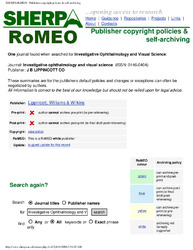| dc.contributor.author | Evans, Irene | en_US |
| dc.contributor.author | Bucher, B. | en_US |
| dc.contributor.author | Ocon, A. | en_US |
| dc.contributor.author | Tapley, J. | en_US |
| dc.date.accessioned | 2006-08-14T14:36:51Z | en_US |
| dc.date.available | 2006-08-14T14:36:51Z | en_US |
| dc.date.issued | 2005 | en_US |
| dc.identifier.citation | Investigative Ophthalmology and Visual Science 46 (2005) E-Abstract 3255 | en_US |
| dc.identifier.issn | 1552-5783 | en_US |
| dc.identifier.uri | http://hdl.handle.net/1850/2276 | en_US |
| dc.description | Article may be found at: http://abstracts.iovs.org/cgi/content/abstract/46/5/3255?maxtoshow=&HITS=30&hits=30&RESULTFORMAT=1&author1=Evans&andorexacttitle=and&andorexacttitleabs=and&andorexactfulltext=and&searchid=1&FIRSTINDEX=0&sortspec=relevance&resourcetype=HWCIT,HWELTR | en_US |
| dc.description.abstract | Purpose: The regression of the pupillary membrane and hyaloid vasculature of the eye was observed in the newborn rat from postpartum days 1–36 by injection of FITC–dextran. We also observed the development of the retinal vasculature. The FITC–dextran method was used to observe changes in the pupillary membrane that covers the front of the lens and the hyaloid artery that comes into the back of the eye through the optic disk and branches into the vasa hyaloidia propria and the tunica vasculosa lentis. Methods: A suspension consisting of the dye fluorescein bound to high molecular weight dextran (FITC) was injected intracardially. After a short wait to allow the heart time to pump the dye throughout the body, the eyes were dissected out and visualized using both an epifluorescent and a confocal microscope. Results: The order of vessel regression appears to be loss of the pupillary membrane (week one) followed by loss of the tunica vasculosa lentis (week two) followed later by the vasa hyaloidia propria. Remnants of the hyaloid artery may persist for up to six weeks. The loss of vessels was gradual and it took several days for all parts of a particular vasculature to disappear. Retinal vasculature formed in the first weeks after birth. Many macrophages (hyalocytes) were labeled by this technique and observed at all stages of development both free and attached to vessels. High resolution confocal images of the pupillary membrane, tunica vasculosa lentis, vasa hyaloidia propria, and hyaloid artery were collected. Conclusions: The regression pattern is generally consistent with that generated from serial analysis of ocular tissue specimens obtained from fixed, sectioned post–mortem eyes. In addition, this in vivo imaging technique provides a view of the complexities of the hyaloid vasculature and the temporal and spatial relationships of its various parts. In vivo epifluorescent and confocal imaging provides new insights into the regression of the hyaloid vasculature and the development of the retinal vasculature. | en_US |
| dc.format.extent | 40100 bytes | en_US |
| dc.format.mimetype | application/pdf | en_US |
| dc.language.iso | en_US | en_US |
| dc.publisher | Association for Research in Vision and Ophthalmology: Investigative Ophthalmology and Visual Science | en_US |
| dc.subject | Confocal imaging | en_US |
| dc.subject | Eye | en_US |
| dc.subject | Hyaloid | en_US |
| dc.title | Visualization of the regression of the hyaloid vasculature and retinal vessel formation in the newborn rat using FITC/Dextran | en_US |
| dc.type | Abstract | en_US |

